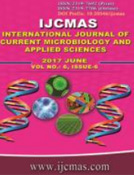


 National Academy of Agricultural Sciences (NAAS)
National Academy of Agricultural Sciences (NAAS)

|
PRINT ISSN : 2319-7692
Online ISSN : 2319-7706 Issues : 12 per year Publisher : Excellent Publishers Email : editorijcmas@gmail.com / submit@ijcmas.com Editor-in-chief: Dr.M.Prakash Index Copernicus ICV 2018: 95.39 NAAS RATING 2020: 5.38 |
Knowledge of spatial variability in soil fertility is important for site specific nutrient management. In this study, spatial variability in properties that influence soil fertility such as soil organic carbon (OC), available N, available P2O5 and available K2O, secondary and micro nutrients in surface soils (0-30 cm depth) of 67 farmers' fields of Alanatha Cluster Villages, Kanakapura Taluk, Ramanagara District, Karnataka (India) were quantified and the respective thematic maps were prepared on the basis of ratings of nutrients. Arc Map with spatial analyst function of Arc GIS software was used to prepare soil fertility maps. Soils were strongly acidic to slightly acidic in reaction with normal Electrical Conductivity (EC). Soil organic carbon content was low to high, available nitrogen in soil was low to medium, available phosphorus was low to high, available potassium was low to high. Soil sampled area were found to be 100 per cent sufficient in exchangeable calcium, 97 per cent area was found to be sufficient in exchangeable magnesium. Available sulphur status was found to be low to high. The entire area was found to be sufficient in available manganese and copper, 86.57 per cent area was sufficient in zinc and 85.02 per cent area was sufficient in iron in surface soils. The observed spatial variability in various soil properties that influence soil fertility was used for deciding nutrient application to crop. Thus providing balanced nutrients to crop based on analysis of fertility of each parcel of land, which has resulted in enhanced crop productivity and net returns in both finger millet and groundnut cropping system.
 |
 |
 |
 |
 |